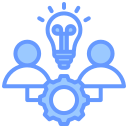Chosen theme: Integrating Diverse Expertise for Innovation. Discover how converging engineers, artists, clinicians, and data scientists unlocks bold solutions. Expect practical frameworks, vivid stories, and conversation prompts—because your perspective might be the missing insight someone else needs. Join in, comment thoughtfully, and subscribe to keep exploring this theme together.
Why Diverse Expertise Accelerates Breakthroughs
Research by Scott E. Page shows groups with varied heuristics often outperform high-ability groups sharing the same perspective. Different lenses generate more candidate solutions, expose hidden assumptions, and prevent groupthink from quietly narrowing what seems possible. Diversity of approach, not just identity, becomes strategic advantage.


Why Diverse Expertise Accelerates Breakthroughs
NASA’s Apollo 13 rescue hinged on cross-functional improvisation—engineers, astronauts, and flight controllers hacking constraints together. Modern open-source communities mirror that power: distributed specialties converge to debug, refactor, and invent at speed, because shared purpose aligns differences into complementary strengths rather than competing egos.
Building Cross-Disciplinary Teams That Actually Work
T-Shaped and Comb-Shaped Collaborators
Recruit individuals with depth in one domain and curiosity-driven breadth across adjacent fields. “Comb-shaped” teammates add multiple spikes of depth. Both profiles listen actively, translate constraints, and prototype across boundaries, making integration energizing rather than exhausting. Who in your network fits this profile and could elevate your next project?
Knowledge Brokers and Boundary Spanners
Appoint connectors who shuttle insights between labs, departments, and communities. They curate context, pair people, and protect the slack required for serendipity. Without them, integration starves between meetings. Nominate one broker today and give them legitimacy, time, and a clear narrative mandate to accelerate cross-pollination.
Psychological Safety as the Glue
Amy Edmondson’s research shows teams innovate when members can risk candor without fear. Normalize questions, drafty demos, and respectful dissent. Try a brief “red team minute” in your next review, and tell us whether surprising issues surfaced earlier and cheaper. Safety fuels honest integration and bolder experiments.
Boundary Objects Make Ideas Tangible
Use sketches, prototypes, user journeys, and data schemas as boundary objects that everyone can manipulate. Tangibility lowers interpretive gaps and invites more voices. Bring a rough mock to your next stand-up and watch conversations sharpen without turning adversarial. Then share the most surprising clarification it created.
Glossaries and Kickoff Rituals
Create a living glossary where each discipline defines key terms in plain language and examples. Begin projects by asking, “What do we mean by success, risk, and done?” You will surface conflicts early instead of litigating them under deadline pressure. Post your glossary link and invite suggested additions.
Narrative as the Universal Protocol
Stories travel farther than specs. Frame initiatives as a change narrative with characters, stakes, and constraints. Write story-driven briefs that bridge intentions and measurements, then invite comments from non-obvious experts. Their feedback can stress-test the plot before you invest heavily, saving money and morale.
Double Diamond, Practically Applied
Run divergent discovery with mixed pairs—engineer plus researcher, clinician plus data scientist—then converge on a tight problem definition. Repeat for solutions. Cross-pairing prevents discipline capture and keeps insights flowing bidirectionally, rather than staging handoffs that bleach nuance and stunt adoption.
Systems Mapping Reveals Hidden Constraints
Map causal loops and stakeholders before prototyping. When supply chains, regulations, incentives, and human behavior intersect, diagrams expose leverage points and risks. Post your map for feedback; outside eyes often spot missing actors or feedback delays that fundamentally change where to intervene for real impact.
Tools and Data for Seamless Knowledge Fusion
01
Adopt shared whiteboards and roadmaps that bind problem statements, user insights, technical constraints, and regulatory checkpoints. Seeing dependencies reduces rework and finger-pointing. Ask a colleague from another domain to annotate your canvas with risks you missed, then summarize what changed in your plan.
02
Establish a single source of truth with documented lineage, data contracts, and access policies. When experts trust the same numbers, debate shifts from “whose spreadsheet” to “what decision.” Share your governance approach and invite critique from both analysts and operators to strengthen integrity and usability.
03
Record rationale behind major choices and run short after-action reviews after milestones. These artifacts become searchable memory that accelerates onboarding and prevents repeat mistakes. Post a sanitized example in the comments to inspire others to institutionalize learning without shame or blame.
Leading Indicators, Not Just Lagging Outcomes
Track learning velocity, cross-discipline pairing frequency, and assumption reduction per sprint. These signals predict stronger outcomes later. Publish your dashboard openly, inviting challenges that refine metrics before they calcify into unhelpful targets that distort behavior and quietly penalize collaboration.
Cross-Disciplinary Contribution Index
Create a simple index capturing diversity of input to key decisions—who proposed, who challenged, and who shaped the final path. When the index dips, intentionally widen participation. Share your template so others can adapt it and compare trends across teams without encouraging gaming.
Celebrate Learning, Not Only Launches
Ritualize demos of invalidated assumptions, near-misses, and rescued failures. Recognition changes what teams attempt. Leave a comment describing a courageous experiment you celebrated, so we can amplify practices that normalize thoughtful, evidence-driven risk and make integration safer to pursue consistently.
